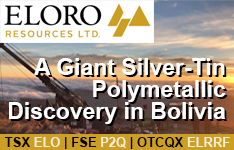 Much of the world's economic gold, silver, copper and lead-zinc deposits are found in vein (lode) deposits. When veins occur in groupings—various discrete yet similar veins clustered in one area—it's referred to as a vein system. Vein systems can hold impressive amounts of valuable minerals.
Much of the world's economic gold, silver, copper and lead-zinc deposits are found in vein (lode) deposits. When veins occur in groupings—various discrete yet similar veins clustered in one area—it's referred to as a vein system. Vein systems can hold impressive amounts of valuable minerals.Most often, vein-hosted gold is invisible to the unaided eye as it is found along with a fair bit of gangue material, including quartz, sulfide, calcite and various clay minerals. Veins range in thickness from a few centimeters to four meters, and they can be several hundred meters long and extend to depths in excess of 1,500m. Mineralization commonly occurs in shoots within the vein structures. Historically, gold grades have been in the 13.7–17.1 g/t range with cutoff around 8.6 g/t; however, as the price of gold has soared and mining technology has improved, so deposits with larger tonnages and lower grades can be mined economically. Both underground and open-pit mining methods are used to extract minerals with the latter used in near-surface vein deposits. With mesothermal vein deposits, which generally occur at greater depths, underground mining is the preferred extraction method.
Formation
Vein deposits form from hydrothermal fluids rising through earth's crust toward its surface. These fluids, commonly created by magma moving through the earth's crust, travel the path of least resistance through fractures and faults in the rock. There are two basic types of vein deposits: epithermal and mesothermal.
Mesothermal veins are formed at moderate temperature and pressure, in and along fissures or fractures in rocks and are known for their large size and depth and, therefore, are a major source of the world's gold production.









































